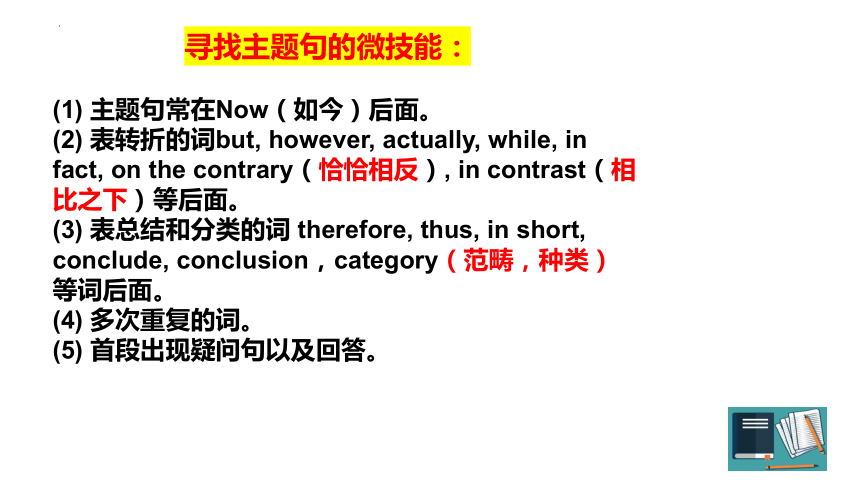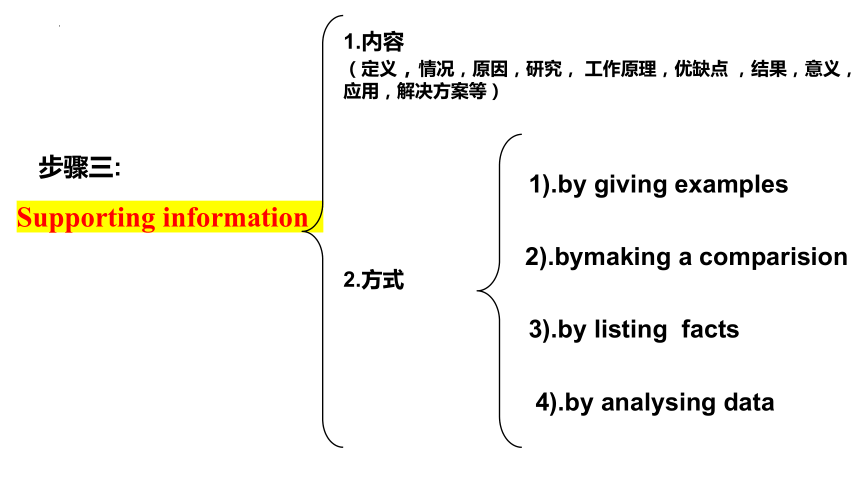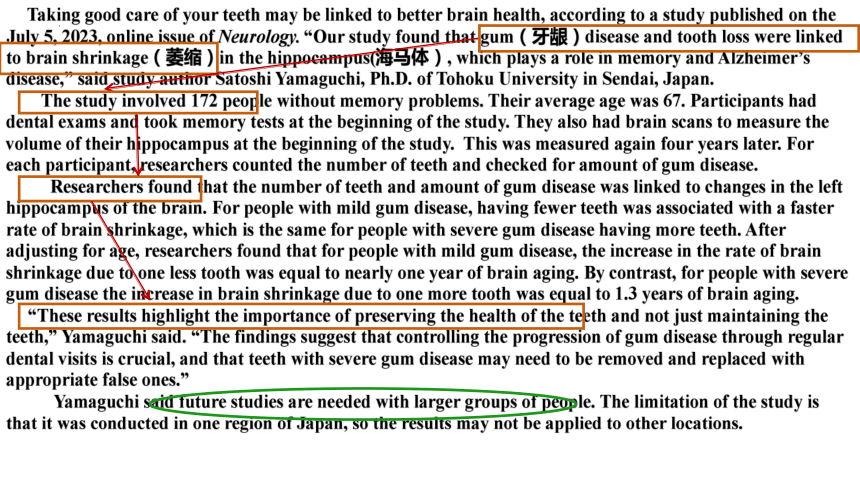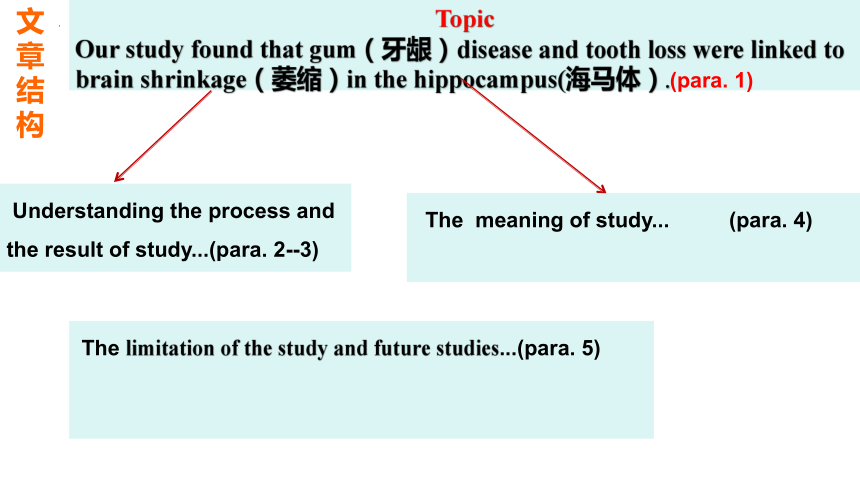2025届高三英语一轮复习解题技巧专项: 阅读理解之说明文解题技巧课件(共12张PPT)
文档属性
| 名称 | 2025届高三英语一轮复习解题技巧专项: 阅读理解之说明文解题技巧课件(共12张PPT) |  | |
| 格式 | pptx | ||
| 文件大小 | 1.0MB | ||
| 资源类型 | 教案 | ||
| 版本资源 | 人教版(2019) | ||
| 科目 | 英语 | ||
| 更新时间 | 2024-10-23 15:27:38 | ||
图片预览






文档简介
(共12张PPT)
阅读理解之
说明文阅读技巧
说明文技巧
步骤一:弄清楚说明文的结构:
步骤二:
Topic
+Supporting information
1 确定位置:首尾段
2.寻找主题句的技能
寻找主题句的微技能:
(1) 主题句常在Now(如今)后面。
(2) 表转折的词but, however, actually, while, in fact, on the contrary(恰恰相反), in contrast(相比之下)等后面。
(3) 表总结和分类的词 therefore, thus, in short, conclude, conclusion,category(范畴,种类)等词后面。
(4) 多次重复的词。
(5) 首段出现疑问句以及回答。
Supporting information
1.内容
(定义,情况,原因,研究, 工作原理,优缺点 ,结果,意义,应用,解决方案等)
2).bymaking a comparision
1).by giving examples
3).by listing facts
4).by analysing data
2.方式
步骤三:
Taking good care of your teeth may be linked to better brain health, according to a study published on the July 5, 2023, online issue of Neurology. “Our study found that gum(牙龈)disease and tooth loss were linked to brain shrinkage(萎缩)in the hippocampus(海马体), which plays a role in memory and Alzheimer’s disease,” said study author Satoshi Yamaguchi, Ph.D. of Tohoku University in Sendai, Japan.
The study involved 172 people without memory problems. Their average age was 67. Participants had dental exams and took memory tests at the beginning of the study. They also had brain scans to measure the volume of their hippocampus at the beginning of the study. This was measured again four years later. For each participant, researchers counted the number of teeth and checked for amount of gum disease.
Researchers found that the number of teeth and amount of gum disease was linked to changes in the left hippocampus of the brain. For people with mild gum disease, having fewer teeth was associated with a faster rate of brain shrinkage, which is the same for people with severe gum disease having more teeth. After adjusting for age, researchers found that for people with mild gum disease, the increase in the rate of brain shrinkage due to one less tooth was equal to nearly one year of brain aging. By contrast, for people with severe gum disease the increase in brain shrinkage due to one more tooth was equal to 1.3 years of brain aging.
“These results highlight the importance of preserving the health of the teeth and not just maintaining the teeth,” Yamaguchi said. “The findings suggest that controlling the progression of gum disease through regular dental visits is crucial, and that teeth with severe gum disease may need to be removed and replaced with appropriate false ones.”
Yamaguchi said future studies are needed with larger groups of people. The limitation of the study is that it was conducted in one region of Japan, so the results may not be applied to other locations.
文章结构
Topic
Our study found that gum(牙龈)disease and tooth loss were linked to brain shrinkage(萎缩)in the hippocampus(海马体).(para. 1)
Understanding the process and the result of study...(para. 2--3)
The meaning of study... (para. 4)
The limitation of the study and future studies...(para. 5)
1.What is Yamaguchi’s study mainly about
A. Causes of gum disease.
B. The symptoms of brain shrinkage.
C. Ways to take good care of one’s teeth.
D. The connection between the teeth and the brain.
主题
Taking good care of your teeth may be linked to better brain health, according to a study published on the July 5, 2023, online issue of Neurology. “Our study found that gum(牙龈)disease and tooth loss were linked to brain shrinkage(萎缩)in the hippocampus(海马体), which plays a role in memory and Alzheimer’s disease,” said study author Satoshi Yamaguchi, Ph.D. of Tohoku University in Sendai, Japan.
(Para.1)
2. How did researchers reach the conclusion
A. By making comparisons.
B. By referring to previous studies.
C. By conducting a survey among dentists.
D.By proving experts’ theory in experiments.
研究过程和方式
The study involved 172 people without memory problems. Their average age was 67. Participants had dental exams and took memory tests at the beginning of the study. They also had brain scans to measure the volume of their hippocampus at the beginning of the study. This was measured again four years later. For each participant, researchers counted the number of teeth and checked for amount of gum disease.
Researchers found that the number of teeth and amount of gum disease was linked to changes in the left hippocampus of the brain. For people with mild gum disease, having fewer teeth was associated with a faster rate of brain shrinkage, which is the same for people with severe gum disease having more teeth. After adjusting for age, researchers found that for people with mild gum disease, the increase in the rate of brain shrinkage due to one less tooth was equal to nearly one year of brain aging. By contrast, for people with severe gum disease the increase in brain shrinkage due to one more tooth was equal to 1.3 years of brain aging.
(Para.2-3)
3. What do the research findings indicate
A. Gum disease is increasing among people.
B. Keeping teeth healthy is of great importance.
C. Removing natural teeth is bad for dental health.
D. Doing a routine dental checkup can avoid gum disease.
研究意义
(Para.4)
These results highlight the importance of preserving the health of the teeth and not just maintaining the teeth,” Yamaguchi said. “The findings suggest that controlling the progression of gum disease through regular dental visits is crucial, and that teeth with severe gum disease may need to be removed and replaced with appropriate false ones.”
4. What is expected of the future studies according to Yamaguchi
A. Exploring treatments for gum disease.
B. Seeking new methods to improve brain health.
C. Involving people from other places in the research.
D. Applying the research to relieve Alzheimer’s disease.
未来的研究
Yamaguchi said future studies are needed with larger groups of people. The limitation of the study is that it was conducted in one region of Japan, so the results may not be applied to other locations.
(Para.5)
2023年新高考试题
On March 7, 1907, the English statistician Francis Galton published a paper which illustrated what has come to be known as the “wisdom of crowds” effect. The experiment of estimation he conducted showed that in some cases, the average of a large number of independent estimates could be quite accurate.
This effect capitalizes on the fact that when people make errors, those errors aren’t always the same. Some people will tend to overestimate, and some to underestimate. When enough of these errors are averaged together, they cancel each other out, resulting in a more accurate estimate. If people are similar and tend to make the same errors, then their errors won’t cancel each other out. In more technical terms, the wisdom of crowds requires that people’s estimates be independent. If for whatever reasons, people’s errors become correlated or dependent, the accuracy of the estimate will go down.
But a new study led by Joaquin Navajas offered an interesting twist (转折) on this classic phenomenon. The key finding of the study was that when crowds were further divided into smaller groups that were allowed to have a discussion, the averages from these groups were more accurate than those from an equal number of independent individuals. For instance, the average obtained from the estimates of four discussion groups of five was significantly more accurate than the average obtained from 20 independent individuals.
In a follow-up study with 100 university students, the researchers tried to get a better sense of what the group members actually did in their discussion. Did they tend to go with those most confident about their estimates Did they follow those least willing to change their minds This happened some of the time, but it wasn’t the dominant response. Most frequently, the groups reported that they “shared arguments and reasoned together”. Somehow, these arguments and reasoning resulted in a global reduction in error. Although the studies led by Navajas have limitations and many questions remain, the potential implications for group discussion and decision-making are enormous.
1. What is paragraph 2 of the text mainly about
A.The methods of estimation. B.The underlying logic of the effect.
C.The causes of people’s errors. D.The design of Galton’s experiment.
2. Navajas’ study found that the average accuracy could increase even if ________.
A.the crowds were relatively small B.there were occasional underestimates
C.individuals did not communicate D.estimates were not fully independent
3. What did the follow-up study focus on
A.The size of the groups. B.The dominant members.
C.The discussion process. D.The individual estimates.
4. What is the author’s attitude toward Navajas’ studies
A.Unclear. B.Dismissive. C.Doubtful. D.Approving.
阅读理解之
说明文阅读技巧
说明文技巧
步骤一:弄清楚说明文的结构:
步骤二:
Topic
+Supporting information
1 确定位置:首尾段
2.寻找主题句的技能
寻找主题句的微技能:
(1) 主题句常在Now(如今)后面。
(2) 表转折的词but, however, actually, while, in fact, on the contrary(恰恰相反), in contrast(相比之下)等后面。
(3) 表总结和分类的词 therefore, thus, in short, conclude, conclusion,category(范畴,种类)等词后面。
(4) 多次重复的词。
(5) 首段出现疑问句以及回答。
Supporting information
1.内容
(定义,情况,原因,研究, 工作原理,优缺点 ,结果,意义,应用,解决方案等)
2).bymaking a comparision
1).by giving examples
3).by listing facts
4).by analysing data
2.方式
步骤三:
Taking good care of your teeth may be linked to better brain health, according to a study published on the July 5, 2023, online issue of Neurology. “Our study found that gum(牙龈)disease and tooth loss were linked to brain shrinkage(萎缩)in the hippocampus(海马体), which plays a role in memory and Alzheimer’s disease,” said study author Satoshi Yamaguchi, Ph.D. of Tohoku University in Sendai, Japan.
The study involved 172 people without memory problems. Their average age was 67. Participants had dental exams and took memory tests at the beginning of the study. They also had brain scans to measure the volume of their hippocampus at the beginning of the study. This was measured again four years later. For each participant, researchers counted the number of teeth and checked for amount of gum disease.
Researchers found that the number of teeth and amount of gum disease was linked to changes in the left hippocampus of the brain. For people with mild gum disease, having fewer teeth was associated with a faster rate of brain shrinkage, which is the same for people with severe gum disease having more teeth. After adjusting for age, researchers found that for people with mild gum disease, the increase in the rate of brain shrinkage due to one less tooth was equal to nearly one year of brain aging. By contrast, for people with severe gum disease the increase in brain shrinkage due to one more tooth was equal to 1.3 years of brain aging.
“These results highlight the importance of preserving the health of the teeth and not just maintaining the teeth,” Yamaguchi said. “The findings suggest that controlling the progression of gum disease through regular dental visits is crucial, and that teeth with severe gum disease may need to be removed and replaced with appropriate false ones.”
Yamaguchi said future studies are needed with larger groups of people. The limitation of the study is that it was conducted in one region of Japan, so the results may not be applied to other locations.
文章结构
Topic
Our study found that gum(牙龈)disease and tooth loss were linked to brain shrinkage(萎缩)in the hippocampus(海马体).(para. 1)
Understanding the process and the result of study...(para. 2--3)
The meaning of study... (para. 4)
The limitation of the study and future studies...(para. 5)
1.What is Yamaguchi’s study mainly about
A. Causes of gum disease.
B. The symptoms of brain shrinkage.
C. Ways to take good care of one’s teeth.
D. The connection between the teeth and the brain.
主题
Taking good care of your teeth may be linked to better brain health, according to a study published on the July 5, 2023, online issue of Neurology. “Our study found that gum(牙龈)disease and tooth loss were linked to brain shrinkage(萎缩)in the hippocampus(海马体), which plays a role in memory and Alzheimer’s disease,” said study author Satoshi Yamaguchi, Ph.D. of Tohoku University in Sendai, Japan.
(Para.1)
2. How did researchers reach the conclusion
A. By making comparisons.
B. By referring to previous studies.
C. By conducting a survey among dentists.
D.By proving experts’ theory in experiments.
研究过程和方式
The study involved 172 people without memory problems. Their average age was 67. Participants had dental exams and took memory tests at the beginning of the study. They also had brain scans to measure the volume of their hippocampus at the beginning of the study. This was measured again four years later. For each participant, researchers counted the number of teeth and checked for amount of gum disease.
Researchers found that the number of teeth and amount of gum disease was linked to changes in the left hippocampus of the brain. For people with mild gum disease, having fewer teeth was associated with a faster rate of brain shrinkage, which is the same for people with severe gum disease having more teeth. After adjusting for age, researchers found that for people with mild gum disease, the increase in the rate of brain shrinkage due to one less tooth was equal to nearly one year of brain aging. By contrast, for people with severe gum disease the increase in brain shrinkage due to one more tooth was equal to 1.3 years of brain aging.
(Para.2-3)
3. What do the research findings indicate
A. Gum disease is increasing among people.
B. Keeping teeth healthy is of great importance.
C. Removing natural teeth is bad for dental health.
D. Doing a routine dental checkup can avoid gum disease.
研究意义
(Para.4)
These results highlight the importance of preserving the health of the teeth and not just maintaining the teeth,” Yamaguchi said. “The findings suggest that controlling the progression of gum disease through regular dental visits is crucial, and that teeth with severe gum disease may need to be removed and replaced with appropriate false ones.”
4. What is expected of the future studies according to Yamaguchi
A. Exploring treatments for gum disease.
B. Seeking new methods to improve brain health.
C. Involving people from other places in the research.
D. Applying the research to relieve Alzheimer’s disease.
未来的研究
Yamaguchi said future studies are needed with larger groups of people. The limitation of the study is that it was conducted in one region of Japan, so the results may not be applied to other locations.
(Para.5)
2023年新高考试题
On March 7, 1907, the English statistician Francis Galton published a paper which illustrated what has come to be known as the “wisdom of crowds” effect. The experiment of estimation he conducted showed that in some cases, the average of a large number of independent estimates could be quite accurate.
This effect capitalizes on the fact that when people make errors, those errors aren’t always the same. Some people will tend to overestimate, and some to underestimate. When enough of these errors are averaged together, they cancel each other out, resulting in a more accurate estimate. If people are similar and tend to make the same errors, then their errors won’t cancel each other out. In more technical terms, the wisdom of crowds requires that people’s estimates be independent. If for whatever reasons, people’s errors become correlated or dependent, the accuracy of the estimate will go down.
But a new study led by Joaquin Navajas offered an interesting twist (转折) on this classic phenomenon. The key finding of the study was that when crowds were further divided into smaller groups that were allowed to have a discussion, the averages from these groups were more accurate than those from an equal number of independent individuals. For instance, the average obtained from the estimates of four discussion groups of five was significantly more accurate than the average obtained from 20 independent individuals.
In a follow-up study with 100 university students, the researchers tried to get a better sense of what the group members actually did in their discussion. Did they tend to go with those most confident about their estimates Did they follow those least willing to change their minds This happened some of the time, but it wasn’t the dominant response. Most frequently, the groups reported that they “shared arguments and reasoned together”. Somehow, these arguments and reasoning resulted in a global reduction in error. Although the studies led by Navajas have limitations and many questions remain, the potential implications for group discussion and decision-making are enormous.
1. What is paragraph 2 of the text mainly about
A.The methods of estimation. B.The underlying logic of the effect.
C.The causes of people’s errors. D.The design of Galton’s experiment.
2. Navajas’ study found that the average accuracy could increase even if ________.
A.the crowds were relatively small B.there were occasional underestimates
C.individuals did not communicate D.estimates were not fully independent
3. What did the follow-up study focus on
A.The size of the groups. B.The dominant members.
C.The discussion process. D.The individual estimates.
4. What is the author’s attitude toward Navajas’ studies
A.Unclear. B.Dismissive. C.Doubtful. D.Approving.
